
The Harrier is a medium-sized dog breed of the hound class, used for hunting hares by trailing them. It resembles an English Foxhound but is slightly smaller, though not as small as a Beagle. The breed has been used since the mid 13th century.

The American Cocker Spaniel is a breed of sporting dog. It is a spaniel type dog that is closely related to the English Cocker Spaniel; the two breeds diverged during the 20th century due to differing breed standards in the US and the UK. In the United States, the breed is usually called a Cocker Spaniel, while elsewhere in the world, it is called an American Cocker Spaniel to distinguish it from its older English cousin. The word cocker is commonly held to stem from their use to hunt woodcock in England, while spaniel is thought to be derived from the breed's origins in Spain.
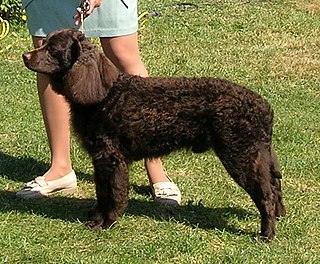
The American Water Spaniel is a breed of spaniel which originated in the United States. It was developed in the state of Wisconsin during the 19th century from a number of other breeds, including the Irish and English Water Spaniels. The breed was saved by Dr. Fred J. Pfeifer, who set up the breed club and standard, and whose work led to recognition for the breed by the United Kennel Club, and later, the American Kennel Club. While they are the state dog of Wisconsin, they remain a rare breed.

The Papillon, also called the Continental Toy Spaniel, is a breed of dog, of the spaniel type. One of the oldest of the toy spaniels, it derives its name from its characteristic butterfly-like look of the long and fringed hair on the ears. A Papillon with dropped ears is called a Phalene.

The Clumber Spaniel is a breed of dog of the spaniel type, developed in the United Kingdom. It is the largest of the spaniels, and comes in predominantly white with either lemon or orange markings. The name of the breed is taken from Clumber Park in Nottinghamshire where the breed was first developed. It is a gundog that specialises in hunting in heavy cover. They are gentle and loyal, and can act aloof with strangers. They have several habits which could be considered disadvantages, including a constant shedding of its coat and snoring.
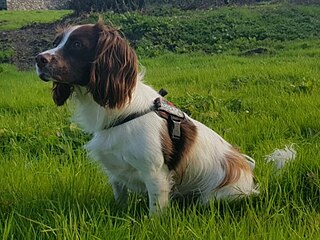
The English Springer is a breed of gun dog in the Spaniel group traditionally used for flushing and retrieving game. They are descended from the Norfolk or Shropshire Spaniels of the mid-19th century; the breed has diverged into separate show and working lines. It is closely related to the Welsh Springer Spaniel and very closely to the English Cocker Spaniel; less than a century ago, springers and cockers would come from the same litter. The smaller "cockers" were used in woodcock hunting while their larger littermates were used to flush, or "spring", other game birds. In 1902, The Kennel Club recognized the English Springer Spaniel as a distinct breed. They are used as sniffer dogs on a widespread basis. The term Springer comes from the historic hunting role, where the dog would flush (spring) birds into the air.

Fox Terriers are two different breeds of the terrier dog type: the Smooth Fox Terrier and the Wire Fox Terrier. Both of these breeds originated in the 19th century from a handful of dogs who are descended from earlier varieties of British terriers, and are related to other modern white terrier breeds. In addition, a number of breeds have diverged from these two main types of fox terrier and have been recognised separately, including the Jack Russell Terrier, Miniature Fox Terrier and Rat Terrier. The Wire and Smooth Fox Terriers share similar characteristics, the main differences being in the coat and markings. They have been successful in conformation shows, more prominently in America than their homeland.

The English Cocker Spaniel is a breed of gun dog. It is noteworthy for producing one of the most varied numbers of pups in a litter among all dog breeds. The English Cocker Spaniel is an active, good-natured, sporting dog standing well up at the withers and compactly built. There are "field" or "working" cockers and "house" cockers. It is one of several varieties of spaniel and is the foundation of its American cousin, the American Cocker Spaniel. The English Cocker is closer to the working-dog form of the Field Spaniel and the English Springer Spaniel. English Cocker Spaniels are also known as the "Merry Spaniel" due to their constantly wagging tail.
Toy dog traditionally refers to a very small dog or a grouping of small and very small breeds of dog. A toy dog may be of any of various dog types. Types of dogs referred to as toy dogs may include spaniels, pinschers and terriers that have been bred down in size. Not all toy dogs are lap dogs.
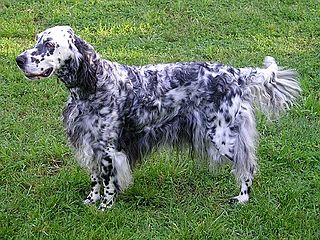
The setter is a type of gundog used most often for hunting game such as quail, pheasant, and grouse.

The Field Spaniel is a medium-sized dog breed of spaniel type. They were originally developed to be all-black show dogs in the late 19th and early 20th centuries and were unpopular for work as a hunting dog. However, during the mid-20th century they were redeveloped as a longer-legged dog that was more suitable to be used for field work. They are now considered to be a rare breed, and are registered as a Vulnerable Native Breed by The Kennel Club.
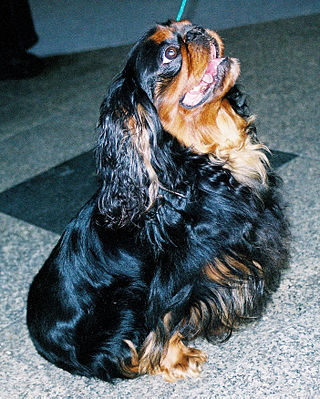
The King Charles Spaniel is a small dog breed of the spaniel type. In 1903, the Kennel Club combined four separate toy spaniel breeds under this single title. The other varieties merged into this breed were the Blenheim, Ruby and Prince Charles Spaniels, each of which contributed one of the four colours available in the breed.
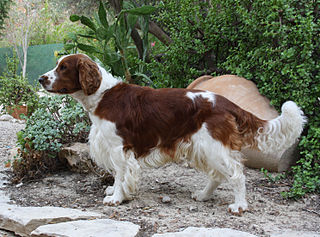
The Welsh Springer Spaniel is a breed of dog and a member of the spaniel family. Thought to be comparable to the old Land Spaniel, they are similar to the English Springer Spaniel and historically have been referred to as both the Welsh Spaniel and the Welsh Cocker Spaniel. They were relatively unknown until a succession of victories in dog trials by the breed increased its popularity. Following recognition by The Kennel Club in 1902, the breed gained the modern name of Welsh Springer Spaniel. The breed's coat only comes in a single colour combination of white with red markings, usually in a piebald pattern. Loyal and affectionate, they can become very attached to family members and are wary of strangers. Health conditions are limited to those common among many breeds of dog, although they are affected more than average by hip dysplasia and some eye conditions. They are a working dog, bred for hunting, and while not as rare as some varieties of spaniel, they are rarer than the more widely known English Springer Spaniel with which they are sometimes confused.

The Boykin Spaniel is a medium-sized breed of dog, a Spaniel bred for hunting wild turkeys and ducks in the Wateree River Swamp of South Carolina, in the United States. It is the state dog of South Carolina, where it was discovered and further developed by hunters in the early through mid 1900s. September 1 is Boykin Spaniel Day in South Carolina, originally established in 1984.

The Sussex Spaniel is a breed of dog native to Sussex in southern England. It is a low, compact spaniel and is as old a breed as and similar in appearance to the Clumber Spaniel. They can be slow-paced, but can have a clownish and energetic temperament. They suffer from health conditions common to spaniels and some large dogs, as well as a specific range of heart conditions and spinal disc herniation.

The French Spaniel is a breed of dog of the Spaniel-like setter. It was developed in France and Canada as a hunting dog, descended from dogs of the 14th century. Popular with royalty during the Middle Ages, it nearly became extinct by the turn of the 20th century but was saved by the efforts of Father Fournier, a French priest. One of the largest breeds of Spaniel, it typically has a white coat with brown markings. It is a friendly breed that has few health issues, but can be affected by a syndrome called acral mutilation and analgesia. The breed is recognised by Canadian and international kennel clubs but not by The Kennel Club (UK). The American Kennel Club has included the breed in its Foundation Stock Service, the first step to full recognition.
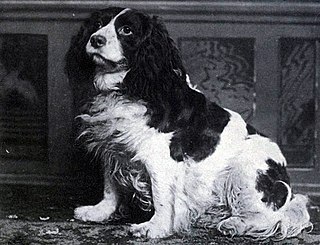
The Norfolk Spaniel or Shropshire Spaniel is an extinct breed of dog since the early 20th century. It was originally thought to have originated from the work of one of the Dukes of Norfolk, but this theory was disproven after being in doubt during the later part of the 19th century. The term was used to designate springer type spaniels that were neither Sussex nor Clumber Spaniels, and attempts were made to use it to specify a breed that would later become known as the English Springer Spaniel.
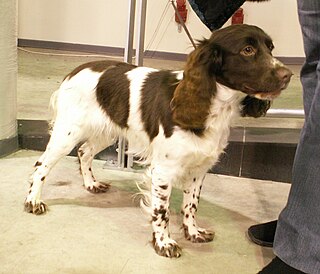
The Russian Spaniel is a type of spaniel first standardised in 1951 in the Soviet Union after World War II by cross breeding English Cocker Spaniels, English Springer Spaniels and other spaniel breeds. In 1951, the standard of the Russian spaniel was adopted, the selection of dogs for breeding began to be carried out in accordance with the requirements. Physically it is similar to a Cocker Spaniel, but has a shorter, tighter coat and a longer body. Developed and used as hunting dogs, this breed does not suffer from any major health complaints other than those normally associated with spaniels. It is the only gun dog breed originated in Russia. It is used for hunting game birds and hares. Popular in its native Russia, the breed was only introduced overseas in the 1990s, and is not yet recognised by any major kennel clubs, but is recognised by Russian Kynological Federation.
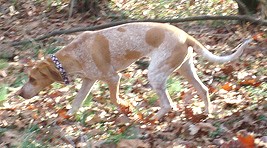
The American English Coonhound, also referred to as the English Coonhound or the Redtick Coonhound, is a breed of coonhound that originated in and is typically bred in the Southern United States. It is descended from hunting hounds, especially foxhounds, brought to America by settlers during the 17th and 18th centuries. The breed's first recognition came from the United Kennel Club in 1905 as the English Fox and Coonhound. Further recognition has been granted in recent years by the American Kennel Club, first in the Foundation Stock Service and in 2011 as a fully recognized member of the hound group.
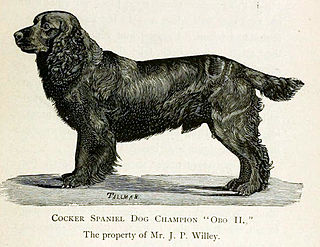
Ch. Obo (1882–1895) was an American Cocker Spaniel who is considered to be the father of the modern breed, though physically, he was different from today's American Cocker. During his day, he was a successful show dog, winner of many Best-in-Show titles.
























